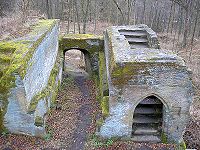
Burg Rotenhan
Encyclopedia

Lower Franconia
Lower Franconia is one of the three administrative regions of Franconia in Bavaria , Germany ....
in the south German state of Bavaria
Bavaria
Bavaria, formally the Free State of Bavaria is a state of Germany, located in the southeast of Germany. With an area of , it is the largest state by area, forming almost 20% of the total land area of Germany...
. Eyrichshof lies within the borough of Ebern
Ebern
Ebern is a town in the Haßberge district, in Bavaria, Germany. It is situated 22 km southwest of Coburg and 23 km northwest of Bamberg.The population of Ebern is about 8,000 people. Its mayor is Robert Herrmann....
in the district of Haßberge. The castle is the ancestral home (Stammsitz) of the House of Rotenhan, a family of imperial knights
Imperial Knight
The Free Imperial Knights, or the Knights of the Empire was an organisation of free nobles of the Holy Roman Empire, whose direct overlord was the Emperor, remnants of the medieval free nobility and the ministeriales...
.
History
The Rotenhan family has its roots in three von Langheim brothers, who were the co-founders of Langheim AbbeyLangheim Abbey
Langheim Abbey was a well-known Cistercian monastery in Klosterlangheim, part of the town of Lichtenfels in Upper Franconia, Bavaria, Germany, in the Bishopric of Bamberg.thumb|250px|Ökonomiehof with decorated fountain at Eastern-History:...
in 1132. Later the name "de Rotha(ha)" was used. In 1229, reference is made to a Winther and Wolfram "de Rotenhagen" in connexion with an allodial
Allodial title
Allodial title constitutes ownership of real property that is independent of any superior landlord, but it should not be confused with anarchy as the owner of allodial land is not independent of his sovereign...
holding of the family rather than a fief. The doorway to the staircase entrance belongs to the late Romanesque
Romanesque architecture
Romanesque architecture is an architectural style of Medieval Europe characterised by semi-circular arches. There is no consensus for the beginning date of the Romanesque architecture, with proposals ranging from the 6th to the 10th century. It developed in the 12th century into the Gothic style,...
-early Gothic
Gothic architecture
Gothic architecture is a style of architecture that flourished during the high and late medieval period. It evolved from Romanesque architecture and was succeeded by Renaissance architecture....
period. In 1323 the castle was besieged by the Bishop of Würzburg
Bishopric of Würzburg
The Bishopric of Würzburg was a prince-bishopric in the Holy Roman Empire, located in Lower Franconia, around the city of Würzburg, Germany. Würzburg was a diocese from 743. In the 18th century, its bishop was often also Bishop of Bamberg...
, Wolfram Wolfskeel von Grumbach, for a year under the pretext of that the family had been involved in counterfeiting and a breach of feudal loyalty. After it was finally captured, the structure was destroyed and, according to a treaty of 1324, was never to be rebuilt. Later, the House of Rotenhan built a new castle, Eyrichshof, further down the hill below the site of Rotenhan.
Literature
- Genealogisches Handbuch des in Bayern immatrikulierten Adels. Band 13. Degener, Neustadt an der Aisch/Mittelfranken 1988, P. 567-578.
- Genealogisches Handbuch des Adels, Vol. 125, Adelslexikon, 2001, C.A. Starke Verlag, ISBN 3-7980-0825-6
- Die Kunstdenkmäler des Königreichs Bayern, III, 15, Bezirksamt Ebern, P. 197-201. (Munich, 1916)
- Isolde Maierhöfer: Ebern (Historischer Atlas von Bayern, Teil Franken , Vol. 15). Munich, 1964
- Joachim Zeune: Burgen im Eberner Land, Ebern 2003, Eberner Heimatblätter, 2 volumes
- Bitha Rotenhan: Rotenhan-Häuser - ein Bilderbuch. Bamberg, 1988
- Gottfried Frhr. von Rotenhan: Die Rotenhan. Genealogie einer fränkischen Familie von 1229 bis zum Dreißigjährigen Krieg. (publications by the Society for Frankish History, Series IX, Vol. 34). Neustadt an der Aisch, 1985
- Julius Frhr. von Rotenhan: Geschichte der Familie von Rotenhan älterer Linie. 2 volumes, 1865
- Siegfried Frhr. von Rotenhan: Geschichte der Familie Rotenhan. Rentweinsdorf, self-publication, 1989

